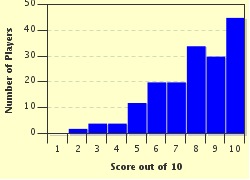Quiz Answer Key and Fun Facts
1. A platypus is a mammal, but is also a monotreme. What separates monotremes from other mammals?
2. What do echidnas eat?
3. Platypus and echidnas are not confined to Australia- in which other country can they be found?
4. Most Australian coins feature a native animal. Which coin depicts the platypus?
5. There are two major species of echidna. What is the major difference, which is reflected in their common names?
6. What is the approximate length of an adult male platypus?
7. What are the origins of the words 'platypus' and 'echidna'?
8. Why could it be hazardous to handle a platypus?
9. Where does the platypus family live?
10. What is a baby echidna called?
Source: Author
ozzz2002
This quiz was reviewed by FunTrivia editor
guitargoddess before going online.
Any errors found in FunTrivia content are routinely corrected through our feedback system.


